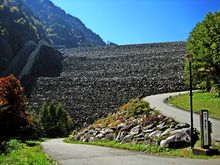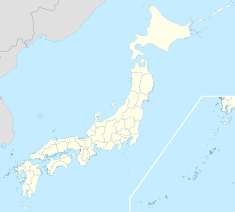- Shin-Takasegawa Pumped Storage Station
-
Shin-Takasegawa Pumped Storage Station 
The Takase DamLocation of Shin-Takasegawa Pumped Storage Station Country Japan Location Ōmachi Coordinates 36°28′26″N 137°41′23″E / 36.47389°N 137.68972°ECoordinates: 36°28′26″N 137°41′23″E / 36.47389°N 137.68972°E Status Operational Construction began 1971 Commission date 1979 Owner(s) TEPCO Reservoir information Upper reservoir Takase Reservoir Reservoir capacity 76,200,000 m3 (61,776 acre·ft) Lower reservoir Nankura Reservoir Reservoir capacity 32,500,000 m3 (26,348 acre·ft) Pumped-storage station information Penstocks 2 Generating units 4 x 320 MW reversible Francis-type Hydraulic head 229 m (751 ft) (net) Power generation information Installed capacity 1,280 MW The Shin-Takasegawa Pumped Storage Station uses the Takase River to operate a pumped storage hydroelectric scheme about 12 km (7 mi) west of Ōmachi in Nagano Prefecture, Japan. Construction on the complex began in 1971, concluded in 1978 and the power station was commissioned in 1979. The power plant has a 1,280 MW installed capacity and its upper reservoir is created by the Takase Dam, a rock-fill dam — which at 176 m (577 ft) in height is the tallest of its type in Japan.[1] It is also the second tallest dam in Japan, next to Kurobe Dam.[2]
Contents
Design and operation
Creating the upper reservoir is the Takase Dam which is a 176 m (577 ft) tall and 362 m (1,188 ft) long rock-fill embankment dam with a structural volume of 11,586,000 m3 (15,153,916 cu yd). The Takase Reservoir has a 76,200,000 m3 (61,776 acre·ft) capacity of which only 16,200,000 m3 (13,134 acre·ft) is active (or "useful") for power generation. The low active capacity of the reservoir is due to the high levels of silt in the Takase River which cause the reservoir to reserve 79 percent of its capacity for this purpose. During operation, the upper reservoir only draws down 10 m (33 ft).[1]
During periods of high energy demand, water from the Takase Reservoir is released down to the power station. After received by the intake, water initially travels along two 8 m (26 ft) diameter and 2,600 m (8,530 ft) long head-race tunnels. At the terminus of these tunnels, they split into four 330 m (1,083 ft) long penstocks which drop down a 200 m (656 ft) deep shaft to the underground power station. At the power station, the water operates four 320 MW reversible Francis turbine-generators before being discharged into the lower reservoir, created by the Nanakura Dam. When energy demand is low and therefore electricity less expensive, the turbines reverse and pump water from the lower reservoir back into the upper reservoir. This process repeats depending upon energy demand and water availability. Water released from the lower reservoir is used to power the Nakanosawa Power Station which uses 140.8 m (462 ft) of hydraulic head to power a single 42 MW Francis turbine generator.[1] It was commissioned in May 1980.[3]
The Nanakura Dam is a 125 m (410 ft) tall and 340 m (1,115 ft) long rock-fill embankment dam with a structural volume of 7,380,000 m3 (9,652,676 cu yd). The reservoir created by the dam, the lower reservoir, has a 32,500,000 m3 (26,348 acre·ft) capacity of which 16,200,000 m3 (13,134 acre·ft) is active. To protect in against rapid draw-down in water levels (as much as 28 m (92 ft)), the top of the dam is coated in hard rock materials.[1]
See also
- Ōmachi Dam - located downstream
- List of pumped-storage hydroelectric power stations
- List of tallest dams in the world
References
- ^ a b c d Engineers, prepared by Task Committee on Pumped Storage of the Committee on Hydropower of the Energy Division of the American Society of Civil (1996). Hydroelectric pumped storage technology : international experience. New York, NY: American Soc. of Civil Engineers. pp. 2.5–1–2.5–4. ISBN 0784401446. http://books.google.com/?id=iCSl-pxL7IwC&pg=PA12&lpg=PA12&dq=Shin+Takasegawa+Pumped+Storage+Station#v=onepage&q=Shin%20Takasegawa%20Pumped%20Storage%20Station&f=false.
- ^ "Takase Dam" (in Japanese). Japan Dam Handbook. http://damnet.or.jp/cgi-bin/binranA/All.cgi?db4=1027. Retrieved 8 August 2011.
- ^ "Tokyo Electric Power Plant Nakanosawa" (in Japanese). Suiryoku.com. http://www.suiryoku.com/gallery/nagano/nknosawa/nknosawa.html. Retrieved 8 August 2011.
External links
- Shin-Takasegawa Power Station at TEPCO
Dams in Nagano Prefecture Achibake Dam · Akiyama Dam · Amekawa Dam · Dorogawa Dam · Haino Dam · Hiraoka Dam · Horikirizawa Dam · Higashijo Dam · Himekawa Dam · Ikusaka Dam · Ikuta Dam · Inagawa Dam · Inekoki Dam · Iwakura Dam · Koya Dam · Kanabara Dam · Katagiri Dam · Kiso Dam · Kitayama Dam · Kosaka Dam · Koshibu Dam · Lake Kutsuzawako Dam · Makio Dam · Matsukawa Dam · Midono Dam · Minakata Dam · Miure Dam · Minamiaiki Dam · Minochi Dam · Minowa Dam · Misogawa Dam · Lake Misuzuko Dam · Miwa Dam · Mizukami Dam · Nagawado Dam · Nanakura Dam · Narai Dam · Nishiotaki Dam · Nishiura Dam · Odagiri Dam · Okususobana Dam · Ōmachi Dam · Onikuma Dam · Otakigawa Dam · Saigawahakuchoko Dam · Sasadaira Dam · Sawando Dam · Sebadani Dam · Sugadaira Dam · Susobana Dam · Taira Dam · Takase Dam · Takato Dam · Tatsugasawa Dam · Tokiwa Dam · Toyoka Dam · Uchimura Dam · Wachino Dam · Yamaguchi Dam · Yasuoka Dam · Yatategi Sabo Dam · Yoji Dam · Yokokawa Dam · Yukawa Dam · Yunose DamCategories:- Dams in Nagano Prefecture
- Hydroelectric power stations in Japan
- Pumped storage power stations
- Rock-filled dams
Wikimedia Foundation. 2010.


